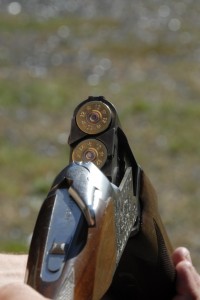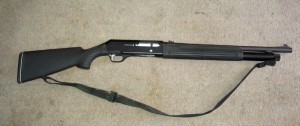A Complete Guide to Clay Pigeon Shooting
Types of Shotgun
3 different designs of 12 bore shotgun exist, Side by Side, Over and Under and Semi-Automatic.
Side by side shotguns are mostly used for game shooting. As their name implies, their two barrels are side by side.
With over and under shotguns, the barrels are on top of each other. These are often used for clay pigeon shooting disciplines.
Semi automatic 12 bores have only one barrel, and the cartridges are loaded into the breech one by one. Some models hold up to 7 cartridges at once, but the majority of licence holders are only licenced to own semi automatic shotguns that will take 3 cartridge shells at a time.
The bulk of adult shooters tend to use 12 bore guns as they offer the perfect combination of performance and weight for the vast majority of clay pigeon targets you will see.
twenty bore shotgun are smaller and lighter making them ideal for use by juniors, ladies and any shooter wanting less recoil when they shoot.
Required Equipment
Shotgun Slip
Gun slips come in a variety of styles, designs, colours and materials including canvas and leather.
Cartridge Bags & Pouches
It will depend on the shooting discipline you are going to be doing as to which type of cartridge holder you opt for. Different shooting disciplines need different bags, pouches or pockets.
Protection For Your Eyes
Flying pieces of broken clay can be very sharp and fast moving. Protecting your eyes from debris is common sense and mandatory at clat shooting clubs in the UK.
Protection for Hearing
Using ear defenders will safeguard your hearing against the repeated bang noise made when shooting. Professional shoots normally insist on ear protection being used during shooting.
Shotgun Cartridges
Most shooters tend to have their preferred cartridges and these are usually a brand that they have shot well with in the past.
Shot gun cartridges have two basic criteria, the lead shot size and the shot speed. The larger the individual lead balls in the shot, the further they will fly, but the less of them there are in the shell. Shells with smaller lead shot have more individual lead balls, but as they each have less mass, they can’t won’t fly as far. Many more experienced shooters will use a different shot sized cartridge for different types of targets depending on their distance.
The ideal velocity for your cartridges will depend on how your coordination interprets the target. Higher velocity cartridges require less ‘lead’ ahead of the target, slower cartridges need more lead.
Popular Clay Shooting Disciplines
Clay Pigeon Skeet Shooting
Skeet clay shooting is the Olympic discipline. Skeet shooting consists of two clay traps which face one another and the targets fly through an identical flight path within a small tolerance.
Skeet uses seven shooting positions, set in a half circle between the 2 trap houses. A skeet round consists of 25 clay targets shot from the 7 stands. It is not unusual to see top shots regularly hit 100 without loss.
Sporting
Sporting clays are more varied because they simulate game. Each week a shooting ground will change their targets so there is always a new challenge for you.
Variety of Clays
‘Standard’ targets have a 110mm diameter and are dome shaped.
A Midi is a smaller standard shaped clay, 90mm in dia.
A Mini is the same design as a standard, but only 60mm dia.. They are quite small and look faster than they usually are, making them especially tricky targets.
Battue – 110mm Diameter – flat, fast and turns and dives when you really hope it wouldn’t.
Rabbit – 55mm radius – is stronger than a standard, designed to run along the ground at high speed.
Principles of Clay Pigeon shooting
Clay pigeon shooting is akin to catching a ball. You don’t put your hand to where the ball is, but where the ball is going to be. Using the same concept, you shoot to place your shot in the flight path of the moving clay.
Shooting involves 2 core skills; hand/eye coordination and the ability to correctly ‘read’ each target.
To break a clay pigeon, the cigar shaped ‘string’ of lead shot needs to meet the clay as it flies through the air.
Because of the distance and speeds involved, accurately ‘reading’ what a target is doing in the air is a vital skill for clay shooting.
Some clays are put on to mislead you as to what they are doing in flight. Some straightforward looking clays are frequently missed for this reason.
Methods of Shooting
The 2 factors that will allow you to hit the target are gun speed and the precise moment in time that you decide to pull the trigger. The two most popular shooting styles are ‘maintain lead’ and ‘swing through’.
Many novice shooters start with the maintain lead method, as it is a more measured technique for shooting many targets. You decide how far in front you need to be. ‘Lead’ is the distance you point your gun ahead of the target. As it flies through the air, you track it with your barrels, keeping the correct distance ahead. When you feel the moment is right, squeeze the trigger and watch the clay shatter.
Instead of measuring each target using maintain lead, more experienced shooters often use a swing through shooting style. Coming from behind, you swing through the target until you have enough lead. Squeeze the trigger while keeping the gun moving and watch the clay break.
Basic Targets
The seven different types of targets simulate the different varieties of game.
Rabbits
Rabbit clays mimic running rabbits. The clays are 55mm in radius and are stronger than standard clays to withstand repeatedly bouncing on the ground.
Teal
Consistently hitting a climbing Teal requires a good swing through technique. Teal are fast moving vertical targets that require practice to hit consistently.
Quartering
Quartering targets usually need less lead than crossing targets. Look to see where the target comes from and where it lands to help you to correctly interpret the flight path of the clay.
Driven Simulated
Hitting a driven target requires a good swing through technique & practice. Driven clays ape driven game flying towards you. You will lose the bird behind your barrels just when you want to pull the trigger, so you have to rely on pure hand eye coordination to know exactly when to shoot.
Incomers
Unlike driven clays, which fly over your head, incomers will land somewhere in front of you.
Going Away Targets
Going away targets become harder to hit very quickly so don’t hang on them or you will miss your chance.
Looper Clays
Loopers are commonly quite far away, and often ‘quarter’ towards or away from you making them even harder. There are different techniques for hitting looping targets depending on whether you favour shooting them as they rise, as they peak, or as they drop.


